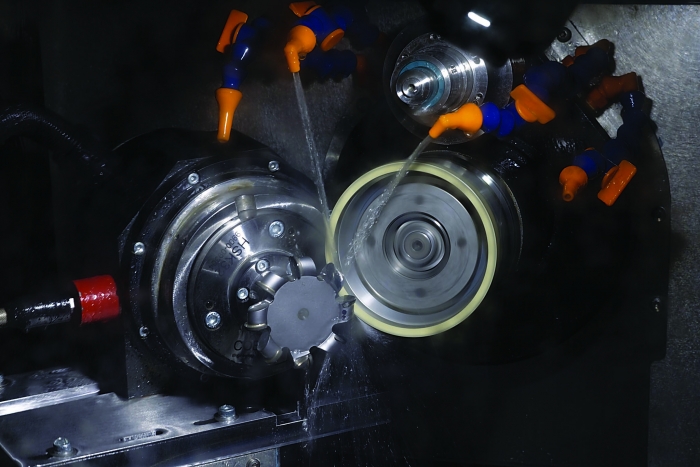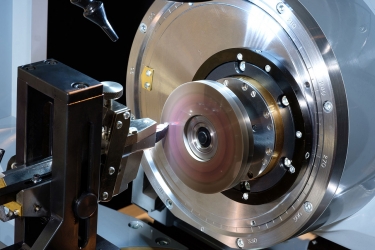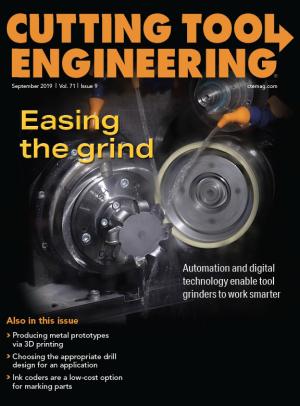Through a partnership with an industrial internet of things specialist, Coborn Engineering Co. Ltd., Romford, U.K., adapted machines for grinding and polishing diamonds into smart equipment by implementing digital services. According to Steve Westlake, managing director of Coborn, the technology from Berlin-based relayr GmbH enables a unique predictive maintenance regime. (Precision International Corp., Haines City, Florida, is the sole authorized agent for Coborn in North America, and relayr’s worldwide corporate headquarters are in Boston.)
“We were planning to develop a ‘smart’ machine but knew that we would have to work with an IoT partner,” Westlake noted in an email. “We then received an email from relayr, which explained their vision and technology. This aligned perfectly with our requirements, so we started the dialogue.”

A cutting tool is ground on a Coborn RG9A grinding machine. Image courtesy of Coborn Engineering
The partnership will help Coborn grinders be more predictive of any failures or breakdowns and other machine optimization recommendations, noted Guneet Bedi, general manager of the Americas for relayr. “As a result, Coborn can reduce downtime and increase revenue streams.”
With anomaly detection through relayr’s artificial intelligence-based analytics, data collected from Coborn’s machines will allow the machine builder to determine and resolve failures in advance. AI-based analytics establishes a normal operation signature for a machine in operation, Westlake explained.
“The machines are being monitored and analyzed constantly, so when the normal signature changes, we are notified of (the) anomaly so that we can investigate this possible problem from the U.K.,” he stated. “If we detect a developing problem, we can contact our customer and plan a machine shutdown to address the problem or plan a visit from one of our service engineers.”
Delivering preemptive service to each customer will enable Coborn to offer machines with guaranteed performance and availability targets, according to the company. The predictive element will allow Coborn to manage most failures, but there will still be random failures, which the company must address, Westlake added.
“We will guarantee that a machine will not be unavailable for a specified period of time depending on which global market the machine is operating in,” he stated. “If we are unable to repair the machine within this time, we will pay the customer an agreed daily rate for lost production.”

Coborn’s PG4 enables automated production of ultrahigh-precision diamond tools. Image courtesy of Coborn Engineering
In addition, Coborn reports that it will offer a pay-per-use business model for its equipment, which is also known as an equipment as a service (EaaS) model. Under this model, Coborn does not sell grinders but makes them available for a usage fee. Coborn will remain responsible for maintenance, service, repairs and parts. This model reportedly makes Coborn’s products easier to finance, especially for companies in developing markets. There will be an agreed monthly payment, which is fixed during the purchase period.
“The customer will not have to pay anything extra at any time during this period,” Westlake noted.
“In addition to helping Coborn offer guaranteed uptime, by using these AI-based solutions we can also help Coborn transition to an EaaS model,” Bedi stated, noting that the model “future-proofs” Coborn’s revenue stream. He added that the EaaS model comes with tax benefits because customers will be able to classify a grinder as an operating expenditure instead of a capital expenditure.
At the end of a grinder’s service life, a customer can purchase the machine for an additional cost, with an option to buy an annual service package, or the customer can replace the grinder with a new one, Westlake stated. The expected service life of a grinder is about 40,000 hours, he added.
“This equates to around five years for a company using the machine 24 hours a day, seven days a week,” Westlake noted. “We have CNC grinding machines that are still in operation after 20 years of operation.”
Although Coborn has encountered some skepticism about the proposal the partnership is presenting to the industry, Westlake is optimistic about the partnership’s ability to increase asset utilization and make equipment financing easier for the customer.
“We are always looking for new technologies and new process-es that provide solutions for our customers and add value to their businesses,” he stated. “The initial takeoff will be slow as we have to prove the predictive element, but certainly within five years this type of smart machine will be the norm.”
Related Glossary Terms
- computer numerical control ( CNC)
computer numerical control ( CNC)
Microprocessor-based controller dedicated to a machine tool that permits the creation or modification of parts. Programmed numerical control activates the machine’s servos and spindle drives and controls the various machining operations. See DNC, direct numerical control; NC, numerical control.
- grinding
grinding
Machining operation in which material is removed from the workpiece by a powered abrasive wheel, stone, belt, paste, sheet, compound, slurry, etc. Takes various forms: surface grinding (creates flat and/or squared surfaces); cylindrical grinding (for external cylindrical and tapered shapes, fillets, undercuts, etc.); centerless grinding; chamfering; thread and form grinding; tool and cutter grinding; offhand grinding; lapping and polishing (grinding with extremely fine grits to create ultrasmooth surfaces); honing; and disc grinding.
- grinding machine
grinding machine
Powers a grinding wheel or other abrasive tool for the purpose of removing metal and finishing workpieces to close tolerances. Provides smooth, square, parallel and accurate workpiece surfaces. When ultrasmooth surfaces and finishes on the order of microns are required, lapping and honing machines (precision grinders that run abrasives with extremely fine, uniform grits) are used. In its “finishing” role, the grinder is perhaps the most widely used machine tool. Various styles are available: bench and pedestal grinders for sharpening lathe bits and drills; surface grinders for producing square, parallel, smooth and accurate parts; cylindrical and centerless grinders; center-hole grinders; form grinders; facemill and endmill grinders; gear-cutting grinders; jig grinders; abrasive belt (backstand, swing-frame, belt-roll) grinders; tool and cutter grinders for sharpening and resharpening cutting tools; carbide grinders; hand-held die grinders; and abrasive cutoff saws.
- polishing
polishing
Abrasive process that improves surface finish and blends contours. Abrasive particles attached to a flexible backing abrade the workpiece.


